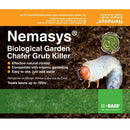Description
UK SHIPMENT ONLY
Chafer beetle larvae attack grass roots and roots of young seedlings. Growth slows and yellow patches appear. Grass is easily pulled up, with little or no root growth. Chafer beetles emerge from the lawn or soil. They lay their eggs, which hatch into grubs feeding on the grass roots before burrowing deep into the ground. They then lie dormant deep in the soil before moving to the surface in the spring to emerge as beetles again.
Wildlife, such as foxes and badgers, can also create a lot of damage as they dig up your lawn and growing spaces in search of grubs for food. Rooks, magpies, crows and woodpeckers feeding on your lawn are a good sign of a chafer grub infestation.
If the chafer's life cycle is not broken re-infestation occurs and the problem gets progressively worse.
Nemasys Chafer Grub Killer: - environmentally friendly and safe for children, pets and wildlife. No need to exclude children and pets from treated areas.
If you have just discovered Chafer Grubs in your lawn or growing space, or had a severe infestation in the past, apply to moist soil during April or May and in August to early October. This is when the young grub larvae are active.
Application in spring may aid control but August to October is the recommended time to apply.
The nematodes come complete with instructions and can be applied using a watering can or nematode applicator. You just apply to moist soil when the soil temperature is above 10ºC (50ºF) and ensure the soil does not dry out for at least two weeks after applying nematodes. Nematodes are capable of surviving the odd frost; so don't worry if the temperature falls after you have applied the nematodes.
Please note Nematodes are live material and cannot be returned. They will usually have an expiry date of around 2 weeks. The effectiveness can sometimes vary due to external factors.
1 pack will treat 500sqm.
PLEASE NOTE : WE CANNOT SHIP THESE OUTSIDE OF THE UK






